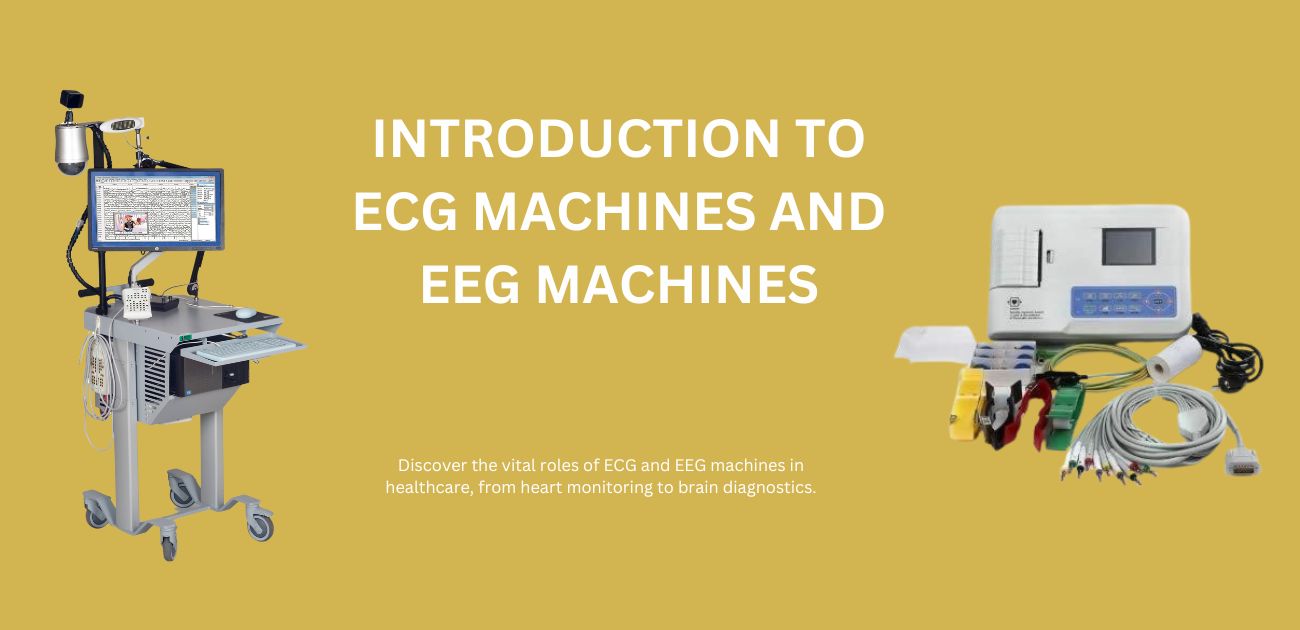Introduction to ECG machines and EEG machines

ECG and EEG machines are super important in medical stuff. They help doctors check the heart and brain by looking at their electrical signals. This guide talks about ECG and EEG machines in a simple way, covering what they do, what parts they have, how they’re used, what’s new with them, what problems they might have, and what’s coming in the future.
Understanding ECG Machines
Definition and Purpose
An ECG machine is a special device that helps doctors check your heart. It records the heart’s electrical activity for a while to determine whether there are any problems, such as irregular heartbeats, heart attacks, or other heart issues.
Components of ECG Machines
An ECG machine has parts like stickers, wires, a speaker, and a recording machine. The stickers go on your chest, arms, and legs to listen to your heart’s electricity. The wires send this electricity to the machine, which makes it louder and records it.
Working Mechanism
An ECG machine works by listening to your heart’s beats. It uses stickers to hear the heart’s electricity, then makes it louder with wires and a machine. The machine shows your heart’s activity on a screen or paper as wavy lines.
Types of ECG Machines
There are different kinds of ECG machines for different uses. Some are for hospitals and clinics, others are small and can be carried around, and there are fancy ones with wireless connections and smart tools for checking the heart’s health.
Understanding EEG Machines
Definition and Purpose
An EEG machine is a very important tool that checks the brain’s electricity. It helps doctors find problems like seizures, brain tumors, and sleep issues by looking at the brain’s wave patterns.
Components of EEG Machines
An EEG machine has parts like small stickers, a machine that makes sounds louder, a computer, and special programs to analyze the information. The stickers go on your head to listen to your brain’s electricity. The machine makes the sounds stronger and changes them into digital information, and the computer reads and understands it.
Working Mechanism
An EEG machine works by listening to your brain’s electricity. It uses stickers to hear the signals, then makes them louder with a machine. The machine turns these signals into pictures called brainwave patterns, showing what your brain is doing.
Types of EEG Machines
There are different kinds of EEG machines. Some are used in hospitals, while others are small and can be carried around. The fancy ones have lots of electrodes, can record videos, and quickly check brain signals to find issues more accurately.
Applications and Importance in Healthcare
Medical Applications of ECG Machines
ECG machines are very important in medicine. They give doctors crucial information about heart problems. They are used in hospitals, clinics, and ambulances to check heartbeats, find issues, and keep an eye on patients during treatments.
Medical Applications of EEG Machines
EEG machines are crucial for diagnosing and treating brain issues. They’re used in neurology clinics and hospitals to examine the brain’s function, detect epilepsy, monitor the brain during surgeries, and detect sleep problems.
Clinical Importance and Benefits
ECG and EEG machines are really helpful because they give doctors quick and accurate information to diagnose problems, plan treatments, and monitor patients. They can find heart and brain issues early, see how well treatments are working, and ensure patients get better care.
Advancements and Innovations in ECG and EEG Technology
Recent Technological Advancements
New improvements in ECG technology include wireless monitors, wearable devices, and phone apps. These help doctors check your heart from far away and make decisions faster. Automatic analysis also helps them understand the results better and quicker.
In EEG technology, new things like better electrodes, smaller machines, and fast data processing have made it easier to see brain signals. Portable EEG devices let doctors check your brain outside the hospital, at home, and for a long time without stopping.
Future Prospects and Trends
The future of ECG and EEG machines looks good. Scientists are studying how to personalize treatments, use AI, and help patients remotely. Combining ECG and EEG can help better understand heart-brain connections and find the best treatments for each person.
Understanding signals better, using computers to learn, and combining all the information will make ECG and EEG machines work even better. Using AI to analyze data, make predictions, and help with decisions can greatly improve how we diagnose problems and care for patients.
Challenges and Ethical Considerations
Technical Challenges and Solutions
Making ECG and EEG machines work better is hard because we need to place the sensors just right, deal with signal problems, remove unwanted stuff, and understand the data well. To fix these issues, we have to keep coming up with new ideas for better sensors, smarter ways to handle signals, and ways to reduce mistakes.
Interpretation Challenges and Training
Understanding ECG and EEG results requires special training and experience. Doctors and technologists must work together, follow specific rules, and learn about different heart and brain patterns to avoid mistakes and give the right diagnoses.
Ethical Considerations in ECG and EEG Testing
When performing ECG and EEG tests, it’s important to consider how to keep patients’ information private, get their permission, and keep data safe. Following rules and protecting data helps protect patients’ rights, keep things private, and ensure people trust healthcare.
Conclusion
In summary, ECG and EEG machines are super important in healthcare. They help us understand how the heart and brain work, find problems and decide on treatments. As they get better and follow good rules, they’ll keep improving healthcare and making life better for patients everywhere.